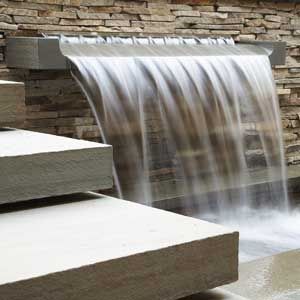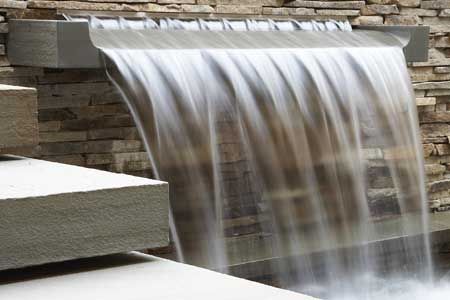
Our Cambridge, Massachusetts, house project demonstrated the beauty of mixing natural elements with Modern architecture.
Arguably the clearest example of this relationship is the magnificent water feature that eases the transition from the busy street to the house’s entrance.
This beauty comes with a price, of course: resource management and maintenance. With a little effort, homeowners can make sure that their water feature doesn’t become an expensive and non-working eyesore.
The Cambridge house water feature—an elevated fountain that pours water into a stunning rectangular basin with natural stone walls—runs under the bluestone staircase leading to the home’s main entrance. It sounds like a babbling brook, and transforms the journey to homeowner George Mabry’s front door from a mere walk to a journey through nature.
The part of Mabry’s water feature that makes the whole so beautiful is its base. Its black-pebble finish captures and scintillates light through the water. The finish is black pebbles and cement, laid an inch thick on the fountain floor.
Then the floor was misted with water to rinse the cement off the top of the pebbles allowing them to shine through. After drying overnight, an acid wash took the remaining film of cement off the top layer of pebbles, leaving a shiny surface.
Mabry’s water feature is on the extravagant side, but the idea is something that can be scaled up or down depending on what you want.
(In the desert Southwest, where a water feature is any use of still or running water in a yard, a fountain like Mabry’s can be very minimal and still be beautiful.)
Adding water features near homes has been happening since the days of rock redoubts because they create an oasis vibe. They replace neighborhood noise with soft, rolling sounds and help untangle jangled nerves.
But before you build a fountain in the middle of your yard, there are some environmental factors you should consider.
The first rule is to consider your water source, says Cathy Rooney, a board member with the Ecological Landscaping Association.
“You want to recycle as much water as possible,” she says, to keep your operating costs lower and to avoid wasting a precious resource.
Think about putting your water feature someplace that offers drain water, such as roof run-off. Such a fountain likely is going to be less expensive to run than one in the middle of the yard that requires running a hose and pumping new water.
Once it’s in the water feature, you can recycle your water easily. Place a waterproof pan—like a fiberglass or resin tray, or even a five-gallon bucket for a small fountain—beneath your water feature. It will collect water that leaks or splashes out, and funnel it back into the water pump.
Speaking of water pumps, buy one with an automatic shut-off that trips if the water level falls too low.
Be sure your system it completely leak-proof and check all the tubing regularly. Each linkage point in the fountain is a potential leak, and leaks will cause evaporation. As the tubing gets older, it may develop kinks or cracks that will stop the water from flowing smoothly through the feature.
To keep the system clean and smooth-running, drain the water every spring and fall—you can transfer it to buckets and re-use the same water for other tasks, and wipe down the surfaces. Harsh cleaners may trump elbow grease when it comes to getting that extra shine, but the chemicals will only work their way back into the groundwater.
During a drought, consider how important it is to you that your water feature remains operational. Each cycle through the fountain, for instance, aerates the water, helping the water evaporate.
“Maybe turn it off during dry months,” says Rooney.
“It’s nice to have a little water feature, that turns your backyard into an oasis instead of a ho-hum spot,” she says.
(The Ecological Landscaping Association offers publications and events focused on how to match your landscaping goals with your environmental concerns. http://www.ela-ecolandscapingassn.org/)

